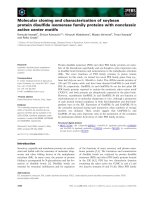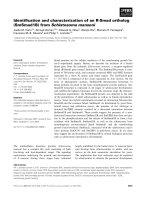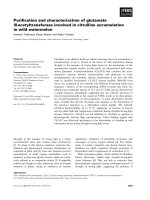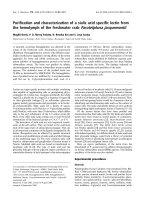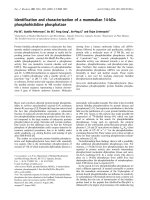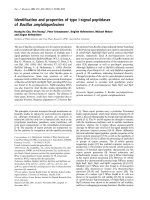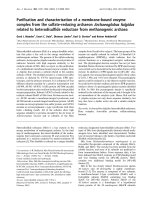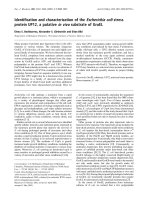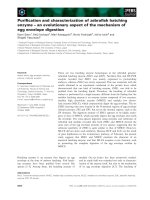Báo cáo khoa học: Identification and characterization of important residues in the catalytic mechanism of CMP-Neu5Ac synthetase from Neisseria meningitidis potx
Bạn đang xem bản rút gọn của tài liệu. Xem và tải ngay bản đầy đủ của tài liệu tại đây (769.72 KB, 12 trang )
Identification and characterization of important residues
in the catalytic mechanism of CMP-Neu5Ac synthetase
from Neisseria meningitidis
Louise E. Horsfall
1
, Adam Nelson
1,2
and Alan Berry
1
1 Astbury Centre for Structural Molecular Biology, University of Leeds, UK
2 School of Chemistry, University of Leeds, UK
Introduction
Eukaryotic cell-surface glycoconjugates often terminate
in a sialic acid molecule, a nine-carbon a-keto acid of
which N-acetylneuraminic acid (Neu5Ac) is the most
abundant [1,2]. Regardless of whether the sialylated
oligosaccharides are joined to lipids or proteins they
play vital roles in cellular interactions. However,
because they are used as recognition markers for ‘self’
cells they have also been implicated in tumour growth
and in autoimmune diseases, and a number of patho-
genic bacteria use these structures to increase their vir-
ulence, mimicking their eukaryotic host’s antigens in
order to evade the immune response [3].
Keywords
CMP-Neu5Ac; enzyme kinetics;
N-acylneuraminate cytidylyltransferase;
sialic acid
Correspondence
A. Berry, Astbury Centre for Structural
Molecular Biology, University of Leeds,
Leeds LS2 9JT, UK
Fax: +44 113 343 7486
Tel: +44 113 343 3158
E-mail:
Re-use of this article is permitted in
accordance with the Terms and Conditions
set out at ey.
com/authorresources/onlineopen.html
(Received 4 March 2010, revised 22 April
2010, accepted 23 April 2010)
doi:10.1111/j.1742-4658.2010.07696.x
Sialylated oligosaccharides, present on mammalian outer-cell surfaces, play
vital roles in cellular interactions and some bacteria are able to mimic these
structures to evade their host’s immune system. It would be of great benefit
to the study of infectious and autoimmune diseases and cancers, to under-
stand the pathway of sialylation in detail to enable the design and produc-
tion of inhibitors and mimetics. Sialylation occurs in two stages, the first to
activate sialic acid and the second to transfer it to the target molecule. The
activation step is catalysed by the enzyme CMP-Neu5Ac synthetase (CNS).
Here we used crystal structures of CNS and similar enzymes to predict resi-
dues of importance in the CNS from Neisseria meningitidis. Nine residues
were mutated to alanine, and the steady-state enzyme kinetic parameters
were measured using a continuous assay to detect one of the products of
the reaction, pyrophosphate. Mutations that caused the greatest loss in
activity included K142A, D211A, D209A and a series of mutations at resi-
due Q104, highlighted from sequence-alignment studies of related enzymes,
demonstrating significant roles for these residues in the catalytic mechanism
of CNS. The mutations of D211A and D209A provide strong evidence for
a previously proposed metal-binding site in the enzyme, and the results of
our mutations at residue Q104 lead us to include this residue in the
metal-binding site of an intermediate complex. This suggests that, like
the sugar-activating lipopolysaccharide-synthesizing CMP-2-keto-3-deoxy-
manno-octonic acid synthetase enzyme KdsB, CNS recruits two Mg
2+
ions
during the catalytic cycle.
Abbreviations
CKS, CMP-Kdo synthetase; CNS, CMP-N-acetylneuraminate synthetase; K-CKS, capsule-specific CMP-Kdo synthetase; Kdn, 2-keto-3-deoxy-
D-glycero-D-galacto-nonulosonic acid; Kdo, 2-keto-3-deoxy-manno-octonic acid; L-CKS, lipopolysaccharide-synthesizing CMP-Kdo synthetase;
Neu5Ac, N-acetylneuraminic acid.
FEBS Journal 277 (2010) 2779–2790 ª 2010 The Authors Journal compilation ª 2010 FEBS 2779
The sialylation of sugars occurs in two stages. First,
a CMP-N-acetylneuraminate synthetase (CNS), also
known as N-acylneuraminate cytidylyltransferase (EC
2.7.7.43), activates the sialic acid by nucleophilic attack
of the O2 atom of Neu5Ac onto the a-phosphate of
CTP in a Mg
2+
-dependent ordered-sequential mecha-
nism to yield CMP-Neu5Ac [4–7]. Second, a sialyl-
transferase adds the activated sialic acid molecule to a
sugar with control of both the regio- and stereo-speci-
ficities of the reaction [8,9].
The only other sugar activated in a similar manner
(i.e. by coupling to a monophosphonucleotide rather
than to a diphosphonucleotide) is 2-keto-3-deoxy-
manno-octonic acid (Kdo) in a reaction performed by
the CMP-Kdo synthetase (CKS) enzyme [3-deoxy-
manno-octulosonate cytidylyltransferase (EC2.7.7.38)]
[10,11]. CNS and CKS share only about 20% amino
acid sequence identity [12] but both enzymes exhibit a
similar a ⁄ b-domain fold, with the major deviation
being at the interface region, where the active sites are
located [12,13]. However, despite these differences,
binding of the nucleotide substrate is similar in the
two enzymes, as demonstrated by the locations and
conformations of nucleotide analogues in the crystal
structures of CNS (PDB 1EYR), ‘capsule-specific’
CKS (K-CKS) (PDB 1GQC and 1GQ9) or lipopoly-
saccharide-synthesizing CKS (L-CKS) (PDB 3K8D)
[13,14].
Previous studies have identified Lys19 in the Haemo-
philus ducreyi CNS, and Lys21 and Arg12 in CNS
from Escherichia coli (Fig. 1) as important catalytic
residues, indicating a role in binding the nucleotide
into the active site [15,16]. The crystal structure of
CNS from Neisseria meningitidis crystallized in the
presence of the substrate analogue CDP confirmed the
interaction between these residues and the first
substrate [12].
Mutation of Arg199, Arg202 or Gln203 to alanine
in murine CNS was shown to abolish activity [17].
Similarly, mutation of the equivalent N. meningitidis
residues (R165A and Q166A; Fig. 1) resulted in
enzymes with either no, or strongly reduced, activity
[17]. In silico docking simulations revealed that Arg165
forms a salt bridge with the carboxylate of the second
substrate, Neu5Ac, whereas Gln166 does not interact
with either substrate but is required in the quaternary
organization of the enzyme [12,17]. This docking also
highlighted several other residues (Ser82, Gln104,
Thr106, Lys142, Arg165, Tyr179, Phe192 and Phe193)
as important in binding the sugar, Neu5Ac [12]. Some
of these residues are conserved in the structures of
murine CNS and the related CKS enzymes (see Figs 1
and 2) [11,18,19].
Crystal structures of CNS have revealed that the
enzyme undergoes significant structural changes on
substrate binding: the CNS from N. meningitidis was
crystallized in an ‘open’ conformation, which allows
entry of the second substrate [12], whereas the murine
CNS was crystallized in a ‘closed’ conformation with
the product CMP-Neu5Ac in the active site [11]. Such
movements are expected to be critical in the correct
positioning of catalytic residues as well as the divalent
metal ions required for catalysis [8]. The N. meningiti-
dis CNS is fully active only in the presence of Mg
2+
Fig. 1. Partial amino acid sequence alignment of CNS enzymes from Neisseria meningitidis [23], Escherichia coli [29], Haemophilus ducreyi
[20], Haemophilus influenza [30], mouse [31] and rainbow trout [24], and the two types of CKS enzymes from E. coli [32–34]. Sequences
were aligned using the C
LUSTALW program [35]. Residues highlighted in black have been identified as important in the literature and have
roles assigned [12–18,20]: *, CTP-binding residue of the P-loop; (*), CTP-binding residue; ^, Neu5Ac-binding residue; #, Neu5Ac-binding
residue forming part of the hydrophobic pocket; °, residue required in the quaternary organization of the molecule; -, residue lining the active
site; +, Mg
2+
-binding residue. Residues highlighted in grey share identity with those highlighted in black.
Characterization of important residues in CNS L. E. Horsfall et al.
2780 FEBS Journal 277 (2010) 2779–2790 ª 2010 The Authors Journal compilation ª 2010 FEBS
ions [5]. Despite this, no electron density has been
reported for metal ions in any CNS enzyme structure
[12,18]. By contrast, in the X-ray structure of the
K-CKS enzyme from E. coli,aMg
2+
ion and a
hydroxide ion were apparent [11,13]. The Mg
2+
ion
was held in place by the bound CTP molecule and
residues Asp225 and Asp98. We propose that these
residues correspond to Asp209 and Asp211 in the
N. meningitidis CNS, and Fig. 3 shows these active-site
residues in comparison with equivalent residues in
the structures of the murine CNS, K-CKS and
L-CKS [13,14,18]. Furthermore, we propose that the
N. meningitidis CNS residue Gln104 corresponds to
the L-CKS residue Gln98, which has recently been
proposed as a Mg
2+
-binding ligand in a product com-
plex, in addition to its initial role in direct ligation of
the sugar OH group in an analogous manner to that
found in the DNA ⁄ RNA polymerase reaction mecha-
nism [14]. We therefore believe that the mechanism
proposed by Heyes et al. for the L-CKS enzyme,
involving two Mg
2+
ions in the enzyme active site and
the nucleophile O2 being created directly by chelation
to the catalytic metal ion [14], can also be applied to
CNS enzymes.
In order to probe these possible roles in substrate
binding and catalysis, a series of nine N. meningitidis
CNS alanine-substitution mutants were created at resi-
dues Gln104, Lys142, Arg173, Asn175, Tyr179,
Phe192, Phe193, Asp209 and Asp211. We chose to
concentrate on these residues because they appear to
contact the N-acetyl group or the glyceryl moiety of
Neu5Ac, and we believe these more functionalized
areas of the molecule are likely to confer the ability to
differentiate Neu5Ac from other sugars, or that they
are residues proposed to form the binding site of the
catalytic Mg
2+
ion. We have determined the kinetic
parameters of the wild-type enzyme from N. meningiti-
dis using a continuous spectrophotometric assay
measuring the release of pyrophosphate during the
reaction, and by comparing the kinetic parameters
determined for the alanine mutants we were able to
identify key catalytic residues and put forward a
revised catalytic mechanism for CNS.
Results and Discussion
In order to make comparisons with the constructed
mutant CNS enzymes, we first measured the steady-
state kinetic parameters of wild-type CNS by following
the rate of formation of the product pyrophosphate,
using a continuous spectrophotometric assay, as
recently used to determine the kinetics of an L-CKS
enzyme [14]. Control experiments in the absence of the
second substrate (Neu5Ac) showed no significant pro-
duction of pyrophosphate, confirming that the assay
was detecting true activity rather than nonproductive
hydrolysis of the CTP. The enzyme showed typical
ordered-sequential kinetic behaviour; it did not bind
Neu5Ac in the absence of CTP, verified by isothermal
titration calorimetry (data not shown), and Linewe-
aver–Burk plots of initial rate against CTP concentra-
tion at various fixed Neu5Ac concentrations, and vice
Phe193
Phe192
Arg71
Arg12
Ser82
Tyr179
Lys142
Gln104
Arg165
Asn175
Thr106
Asp209
Arg173
Asp211
Lys21
Phe193
Phe192
Ser82
Tyr179
Lys142
Arg165
Asn175
Gln104
Thr106
Asp209
Arg173
Asp211
Lys21
Arg71
Arg12
Fig. 2. Cross-eye stereo view of the active site of CNS from Neisseria meningitidis (blue) with CDP (yellow) in the active site (PDB 1EYR)
showing the residues highlighted previously in the literature and those mutated in this study.
L. E. Horsfall et al. Characterization of important residues in CNS
FEBS Journal 277 (2010) 2779–2790 ª 2010 The Authors Journal compilation ª 2010 FEBS 2781
versa, converged. We found some inhibition of the
enzyme activity at high concentrations of CTP, but
values of the true steady-state parameters – V
max
,
K
m(CTP)
and K
m(Neu5Ac)
– were obtained by fitting the
initial rates of reaction, at varying concentrations of
both substrates, to the overall rate equation for a Bi-
Bi ordered sequential mechanism (Table 1). The
K
m(CTP)
of 17 lm is in line with that measured for the
H. ducreyi CNS [20], but significantly lower than that
measured for a number of other bacterial CNS
enzymes. However, we note that our assay was a con-
tinuous enzyme assay rather than the discontinuous
assays often used in the initial characterizations and
that, like the H. ducreyi measurements, our assays
were carried out at physiologically relevant pH (pH
7.5), rather than at higher pH values (pH 8.5-9.0),
which were used in the earlier discontinuous assays
[5,20–22]. In addition, the earlier assays measured the
apparent kinetic values for Neu5Ac at constant CTP
concentrations above those at which we saw substrate
inhibition of the enzyme, accounting for the other
differences observed for the values of K
m(Neu5Ac)
and
k
cat
[5,23] (Table 1).
The necessity of including a sulfhydryl reagent, such
as dithiothreitol, in the assay reaction to give the full
activity of the enzyme has previously been reported,
and such reagents are generally added to assays
[5,8,23]. In contrast, we found no such addition neces-
sary. The CNS enzymatic activity, as measured by
apparent values of k
cat
and K
m(Neu5Ac)
, at a fixed CTP
concentration of 154 lm and five different Neu5Ac
concentrations, were 560 ± 30 s
)1
and 190 ± 20 lm,
respectively, in the presence of 0.2 mm dithiothreitol,
compared with 540 ± 10 s
)1
and 130 ± 9 lm in its
absence.
In order to identify residues in the wild-type
N. meningitidis CNS with potential roles in substrate
discrimination or in forming the binding site for
AB
CD
Gln96
Asp98
Asp225
Gln104
Asp209
Asp211
Gln141
Asp245
Asp247
Gln98
Asp100
Asp235
Fig. 3. Metal-binding residues of CNS and related enzymes. (A) Gln96, Asp225 and Asp98 in the active site of K-CKS (cyan) (PDB 1GQ9)
[13]; (B) Gln104, Asp211 and Asp209 in the Neisseria meningitidis enzyme (blue) (PDB 1EYR) [12]; (C) Gln98, Asp235 and Asp100 in L-CKS
(purple) (PDB 3K8D) [14] (in addition, a second metal-binding site has been modelled in this enzyme coordinated by the b- and c-phosphates
of the CTP); and (D) the metal-binding residues deduced from the alignment in the structure of the murine CNS (green) (PDB 1QWJ) [18].
When present in the crystal structures, CTP, CDP, Kdo and CMP-Neu5Ac in the active sites are coloured by atom type with the carbon set
as yellow. Mg
2+
is coloured in grey.
Characterization of important residues in CNS L. E. Horsfall et al.
2782 FEBS Journal 277 (2010) 2779–2790 ª 2010 The Authors Journal compilation ª 2010 FEBS
the Mg
2+
ion required in catalysis, we studied both
sequence and structural alignments. Structural
alignment (Fig. 4) of the N. meningitidis CNS active
site containing CDP [12] onto the murine CNS active
site containing CMP-Neu5Ac (PDB code 1QWJ) [18]
suggested that the substrates for the two enzymes
would bind in very similar positions and orientations
[12], and we therefore identified nine residues in the
CNS crystal structure (PDB 1EYR) – Gln104, Lys142,
Arg173, Asn175, Tyr179, Phe192, Phe193, Asp209 and
Asp211 – which we believed to be important in bind-
ing Neu5Ac. Alanine replacement mutations were cre-
ated separately at each of these positions, the enzymes
were purified and the effect of mutation was deter-
mined kinetically (Tables 1 and 2).
Enzyme to N-acetyl contacts
Tyr179, Phe192 and Phe193 are proposed to interact
with the methyl group of the N-acetyl moiety of
Neu5Ac, forming a hydrophobic pocket that allows
the methyl group of the N-acetyl moiety to bind into
what is otherwise a very polar active site [12]. Muta-
tions of Phe192 and Phe193 to alanine were con-
structed and the kinetic parameters of the purified
F192A and F193A mutant enzymes were obtained in
the same way as the wild-type enzyme (Table 1). The
results support the role of these residues in binding
Neu5Ac, because the mutants have k
cat
values compa-
rable to that of the wild-type enzyme but K
m
values
indicative of a ‘poorer’ substrate with lower affinity
Tyr227
Leu228
Ile124
Tyr216
Phe176
Asn212
Asp245
Arg202
Asp247
Gln203
Tyr227
Leu228
Ile124
Tyr216
Phe176
Asn212
Asp245
Asp247
Gln203
Arg202
Phe192
Tyr179
Phe193
Lys142
Asn175
Asp209
Asp211
Arg165
Gln166
Phe193
Phe192
Tyr179
Lys142
Asn175
Asp209
Gln166
Arg165
Asp211
Fig. 4. Cross-eye stereo-view of the residues of interest (blue) in the active site of the CNS from Neisseria meningitidis containing CDP
(yellow) (PDB 1EYR) [12] superimposed with their equivalent residues (green) of the murine CNS containing CMP-Neu5Ac (yellow) (PDB
1QWJ) [18]. All residues are numbered, with the exception of Gln104 in the N. meningitidis CNS equivalent to Gln141 in the murine enzyme,
which are shown at the back of the view behind the sialic acid molecule.
Table 1. True kinetic parameters determined for wild-type and mutant CNS. True kinetic parameters, k
cat
, K
m(CTP)
and K
m(Neu5Ac)
were
obtained by fitting initial rates of reactions measured at varying concentrations of CTP and Neu5Ac to the appropriate ordered-sequential Bi-
Bi rate equation using nonlinear regression.
k
cat
(min
)1
) K
m(CTP)
(lM) K
m(Neu5Ac)
(lM) k
0
a
(lM)
k
cat
⁄ K
m
(lM
)1
Æmin
)1
) CTP
k
cat
⁄ K
m
(lM
)1
Æmin
)1
)
Neu5Ac
WT 610 ± 4 17 ± 1 68 ± 1 190 ± 5 36 8.9
Q104A 130 ± 2 31 ± 2 2600 ± 90 180 ± 8 4.3 0.051
R173A 420 ± 3 48 ± 1 290 ± 5 320 ± 7 8.6 1.4
N175A 1500 ± 20 270 ± 8 1600 ± 50 550 ± 20 5.4 0.93
Y179A 3.1 ± 0.2 40 ± 10 110 ± 40 290 ± 100 0.077 0.028
F192A 1200 ± 6 150 ± 3 380 ± 3 2400 ± 20 7.9 3.1
F193A 300 ± 5 52 ± 3 780 ± 20 310 ± 10 5.8 0.38
D211A 0.041 ± 0.003 26 ± 5 66 ± 10 37 ± 10 1.6 · 10
)3
6.2 · 10
)4
D209A Insufficient activity to determine the kinetic parameters when 50 nmol of enzyme present
L. E. Horsfall et al. Characterization of important residues in CNS
FEBS Journal 277 (2010) 2779–2790 ª 2010 The Authors Journal compilation ª 2010 FEBS 2783
for the enzyme active site. The mutation of Tyr179
(Y179A) also significantly affects the kinetic parame-
ters for the enzyme, although, in this case, the major
alterations appear as a 200-fold decrease in k
cat
rather
than substantial changes in K
m
for either substrate
(Table 1). This result might be caused by a mis-posi-
tioning of the substrate in the active site, or to other
consequences of the enzyme mechanism (see below).
Mosimann et al. [12] also propose that the hydropho-
bic pocket plays a role in substrate discrimination
against binding of the 5-OH group of Kdo and in
favour of the N-acetyl group of Neu5Ac and,
although these residues are conserved in CNS
enzymes, none is conserved in the related CKS
enzymes. In addition, we found that 2-keto-3-deoxy-
d-glycero-d-galacto-nonulosonic acid (Kdn), a sialic
acid that only differs from Neu5Ac by possessing a
hydroxyl group at position 5, rather than an N-acetyl,
has a k
cat
⁄ K
m
value around 5000 times lower than the
natural substrate, Neu5Ac. This contrasts with the
murine enzyme, which has a less pronounced pocket
consisting of Ile124, Leu228 and Tyr227, and which
exhibits only a 15-fold lower activity [18,24]. More
significantly, the only sialic acid-activating enzyme
reported to exhibit a preference for Kdn over Neu5Ac
is an enzyme from rainbow trout, which has yet to be
structurally resolved. The sequence alignment in
Fig. 1 suggests that the rainbow trout enzyme has
both the Ile113 and Leu216 residues of the murine
hydrophobic pocket, while the Tyr is absent [24,25].
Therefore, evidence clearly suggests the requirement
for three hydrophobic residues in forming a binding
pocket that allows the enzyme a preference for
Neu5Ac over Kdn.
Enzyme to glyceryl moiety contacts
In the docking studies of Mosimann et al. [12], the
hydroxyl group of Tyr179 lies within hydrogen-bonding
distance of O7 and O9 of the glyceryl moiety of
Neu5Ac, and a network of noncovalent bonds between
enzyme and substrate is proposed in the active site
upon substrate binding [12]. This network is important
in correctly positioning the substrate, active-site metal
ions and the associated water or hydroxide ions [6]
ready for catalysis. The kinetic parameters determined
for the Y179A mutant (Table 1), showing a 200-fold
decrease in its k
cat
value, demonstrate that the
hydroxyl group of Tyr179 plays an important role in
catalysis, supporting the view that an organized
hydrogen-bonding network around this residue may be
important.
The same region of the Neu5Ac, namely the O9
atom, lies at the base of the binding pocket formed by
the backbone atoms of Asn175 [12,18] (Fig. 4).
Although site-directed mutations cannot change the
nature of the backbone, we nevertheless mutated
Asn175 to alanine to see the effect of the mutation.
The N175A mutation had surprising effects, with
increases in the K
m
values for both CTP (16-fold) and
Neu5Ac (23-fold) (Table 1). It seems most likely that
the packing of the side-chain of this residue holds the
backbone in an orientation that stabilizes the active
conformation of the whole active site and that a
change in this packing can be felt throughout the
active site.
When the residue Arg173 was mutated to alanine, a
small increase, of less than five-fold, was seen in the
K
m
of the enzyme (Table 1). The small difference is a
result of the residue being relatively far from both
substrates whilst still making up part of the active site
(Fig. 4). By contrast, the mutation of Lys142 to
alanine produces an enzyme with extremely low levels
of activity. Experiments with as much as 0.33 mg of
enzyme per assay, varying CTP concentration in the
presence of a fixed concentration of Neu5Ac of
0.615 mm, allowed us to estimate a value for the
apparent K
m
for CTP and the apparent k
cat
for the
Table 2. Apparent kinetic parameters determined for wild-type and mutant CNS. Apparent kinetic parameters, k
cat
, K
m(CTP)
and K
m(Neu5Ac)
were obtained by fitting initial rates of reactions measured at varying concentrations of one substrate, at a fixed concentration of the other,
to the Michaelis–Menten equation using nonlinear regression. The fixed concentrations were [CTP] = 0.154 m
M and [Neu5Ac] = 0.615 mM.
k
cat(app)
(min
)1
)
CTP
K
m(app)
(lM)
CTP
k
cat(app)
⁄ K
m(app)
(lM
)1
Æmin
)1
)
CTP
k
cat(app)
(min
)1
)
Neu5Ac
K
m(app)
(lM)
Neu5Ac
k
cat(app)
⁄ K
m(app)
(lM
)1
Æmin
)1
)
Neu5Ac
WT 540 ± 30 34 ± 5 16 540 ± 10 130 ± 9 4.1
Q104A – – – 110 ± 9 4700 ± 900 0.024
Q104L 0.17 ± 0.01 150 ± 20 1.1 · 10
)3
– – 2.9 · 10
)4
±1· 10
)5
Q104E 0.046 ± 0.001 200 ± 9 2.3 · 10
)4
0.027 ± 0.001 310 ± 40 8.7 · 10
)5
Q104N 0.74 ± 0.03 32 ± 4 0.023 – – 7.5 · 10
)4
±2· 10
)5
K142A 0.056 ± 0.002 140 ± 10 3.8 · 10
)4
– – 3.6 · 10
)5
±2· 10
)6
Characterization of important residues in CNS L. E. Horsfall et al.
2784 FEBS Journal 277 (2010) 2779–2790 ª 2010 The Authors Journal compilation ª 2010 FEBS
reaction. These values were compared with values for
the wild-type enzyme measured under identical condi-
tions (Table 2). This revealed a 10 000-fold reduction
in k
cat
with an insignificant, fourfold, rise in K
m
for
CTP. Despite running enzyme assays with up to
41 mm Neu5Ac in the presence of a fixed concentra-
tion of CTP of 0.154 mm, it was not possible to satu-
rate the enzyme, and only an estimate of the k
cat
⁄ K
m
for Neu5Ac could be made from the gradient of the
line obtained in the initial rate versus the Neu5Ac con-
centration plot. This showed a value 100 000-fold
lower than for the wild-type enzyme.
CNS is a dimeric enzyme, with the enzyme active
site being composed of residues from both subunits.
Lys142 from one subunit contributes to the active site
of the other subunit, and we therefore investigated
whether its mutation (K142A) had affected either the
folding or dimerization of the polypeptide chain. The
CD spectrum of the mutant was identical to that of
the wild-type enzyme, and gel filtration showed that,
like the wild-type enzyme, the mutant enzyme was
present as a dimer, thus confirming that the K142A
mutant had folded and dimerized correctly (data not
shown). Lys142 is semiconserved in the CNS family,
also being found in the enzymes from Haemophilus
influenzae and H. ducreyi [20]. Lys142 has been
proposed to interact with the O7 and ⁄ or the O9 of the
glyceryl part of Neu5Ac [12] but its role is not clear,
partly because of the lack of detail on Neu5Ac binding
in CNS enzymes. Our findings suggest a major role in
catalysis for Lys142. The small changes in Michaelis
constants for substrates in the K142A mutant, coupled
with the distance estimated between the modelled posi-
tion of Neu5Ac and Lys142, suggests to us an indirect
role in obtaining the correct active-site geometry for
activity. We propose that Lys142 is vital in positioning
residue Arg165 so that it forms a salt bridge with the
carboxylate of the Neu5Ac substrate [12]. Munster
et al. [17] have previously shown that the R165A
mutation creates an enzyme with no activity and that
mutation of the neighbouring Gln166 to alanine also
reduces the activity strongly. The crystal structure of
CNS in complex with CDP [12] shows that this section
of the polypeptide is intimately involved in the active
site – Glu162 is part of the enzyme active site [12] and
the neighbouring Gln163 plays a role in controlling the
position of residue 165 because the residue in position
164 is proline. Gln163 is, in turn, positioned by its
backbone hydrogen bonding to Lys142 (Fig. 5). We
believe that the mutation K142A therefore not only
limits the possibility of its own interactions with the
substrate, but, more importantly, prevents Arg165
from being correctly positioned to neutralize
the negative charge of the carboxylate group of the
second substrate, sialic acid, resulting in the incorrect
alignment of substrates for catalysis and hence the
significant decreases in k
cat
observed.
Metal-binding-site mutations
Previous work has proposed that the metal-binding
site of the N. meningitidis CNS is composed of
residues Asp209 and Asp211 [12]. The X-ray crystal
structure of the K-CKS from E. coli, which carries out
the same reaction on a similar substrate, has provided
further evidence for the location of the Mg
2+
ion in
the CNS enzyme [13]. This structure reveals that the
metal-binding site is composed of residues Asp98 and
Asp225, placed similarly to residues Asp209 and
Asp211 in the N. meningitidis CNS, despite the lack of
agreement in the sequence alignment of the CNS and
CKS enzymes for these residues (Fig. 1) [13]. Recently,
in the enzyme L-CKS, Gln98 (equivalent to Gln104 in
the N. meningitidis enzyme) has been proposed as a
third metal-binding residue [14], binding a single
Mg
2+
ion in the product complex. The structural
similarity between these residues in CNS, K-CKS
and L-CKS is shown in Fig. 3. We investigated
the role of these three residues using site-directed
mutagenesis.
The D209A mutation showed the greatest effect,
eliminating the enzymatic activity to such a degree that
the kinetic parameters could not be determined
(Table 2). Similarly, the D211A mutation had a crip-
pling effect on activity. In this case we were able to
measure the kinetic parameters for the mutant enzyme
(Table 2). While these showed minor effects on the K
m
for either substrate, the k
cat
for the reaction was
decreased 15 000-fold. These findings strongly support a
2.8
Pro164
Gln163
Glu162
Arg165
Lys142
Fig. 5. The interactions of residue Lys142 in the CNS from
Neisseria meningitidis (blue). The hydrogen bond formed with the
backbone of Gln163 is shown in pink with the distance given in
angstroms.
L. E. Horsfall et al. Characterization of important residues in CNS
FEBS Journal 277 (2010) 2779–2790 ª 2010 The Authors Journal compilation ª 2010 FEBS 2785
major role for Asp209 and Asp211 in the coordination
of the catalytically critical Mg
2+
ion. The two aspartic
acid residues would interact with the b- and c-phos-
phate groups of CTP, as is common in nucleotide-
binding enzymes [12]. Magnesium has been shown to
be an essential cofactor in the enzyme CNS [5] and is
typically included in our assays at a concentration of
1mm. Because mutation of metal-binding residues
would be expected to reduce the affinity of the enzyme
for Mg
2+
, we decided to investigate the effect of
increasing the Mg
2+
concentration to 10 mm. Despite
previous reports suggesting that 10 mm Mg
2+
is
required for optimal activity [5], this addition had no
effect on the level of activity of the wild-type enzyme
(Fig. 6). This is probably because of the lower pH of
our reaction and because the CTP concentrations used
here were much lower than previously used. However,
similar treatment of the D211A mutant increased the
activity by more than four-fold. Increasing the concen-
tration of Mg
2+
had little effect on the D209A
mutant. These differences perhaps reflect the nature of
the binding from the two residues. Asp209 is proposed
to make a bidentate interaction with Mg
2+
, whereas
Asp211 would make only a monodentate interaction
with Mg
2+
and would also bind the hydroxyl ⁄ water
molecule ligated to the Mg
2+
ion, as suggested for its
similar residue in the CKS enzymes [13,14].
The role of Gln104 in Mg
2+
binding and ⁄ or cataly-
sis is less clear. In contrast to the major decrease in
k
cat
of the enzyme when Asp209 or Asp211 were
mutated to alanine, the Q104A mutant manifested its
most significant change in the kinetic parameter of the
K
m
for Neu5Ac, with only fivefold and twofold
decreases in k
cat
and K
m(CTP)
, respectively, while the
K
m(Neu5Ac)
rose by 40-fold (Table 1). These findings
appear to reflect a significant role in substrate recogni-
tion rather than catalysis. Mosimann et al. [12] have
proposed that this highly conserved residue would
interact with the ribose of CTP, and the O8 and N5
positions of Neu5Ac, and that it might be a key resi-
due in discriminating between sialic acid substrates
with different functional groups at C6. The small
changes in K
m
for CTP on mutation to alanine do not
suggest a major role in CTP binding, if one assumes
that the K
m(CTP)
is a reflection of the binding affinity
for that substrate. However, the significant increase in
K
m(Neu5Ac)
would support a role in binding that sub-
strate. In order to investigate this further we made a
series of mutations at Gln104. We maintained the
length of the side chain at this position while introduc-
ing a negative charge by a Q104E mutation, shortened
the chain while maintaining H-bonding capacity in a
Q104N mutation and provided a hydrophobic residue
larger than alanine in a Q104L mutant. All of these
proteins were over-expressed successfully and attempts
were made to measure the true k
cat
and K
m
values.
This proved impossible because of difficulties in satu-
rating the enzyme with Neu5Ac and we resorted to
measuring the apparent values of the kinetic parame-
ters at fixed concentrations of the other substrate
(Table 2; see above).
Maintaining the nature of the residue at position
104 (Q104N mutant) resulted in no change to the
apparent K
m
for CTP, while the introduction of a
charged residue (Q104E) or a larger hydrophobic resi-
due (Q104L) increased the apparent K
m
for CTP by
only four- to sixfold. By contrast, these mutations had
major effects on the K
m
for Neu5Ac. An accurate esti-
mate for this parameter could only be found for the
Q104E mutation because it was not possible to carry
out assays with sufficiently high concentrations of
Neu5Ac to saturate the other enzymes, and plots of
the initial rate versus Neu5Ac concentration were
always linear. The Q104E mutation caused the appar-
ent K
m
for Neu5Ac to increase by twofold, but the
other mutations caused at least a 100-fold increase.
Maintaining the length and hydrogen-bonding poten-
tial of the residue at position 104 (Q104E) therefore
appears to be critical for Neu5Ac binding, while
the introduction of hydrophobic residues (Q104A
or Q104L) or shortening the side chain (Q104N) at
this position is detrimental. However, we noted that
mutations at Gln104 also had significant effects on the
k
cat
of the enzyme reaction. While the true k
cat
mea-
sured for the Q104A mutant (Table 1) fell only by
five-fold, the apparent values measured for the Q104L,
Q104E and Q104N mutants fell by between 800- and
200
400
600
800
1 mM MgCl
10 mM MgCl
0
WT D209A D211A Q104N Q104E
Percentage activity (%)
CNS mutants
Fig. 6. The effect of increased [Mg
2+
] on enzyme activity. Percent-
age change of activity of wild-type CNS and mutants upon the
addition of MgCl
2
to a concentration of 10 mM. The rate of reaction
for each variant using 154 l
M CTP and 615 lM Neu5Ac in standard
reaction buffer (1 m
M MgCl
2
) was taken as 100%.
Characterization of important residues in CNS L. E. Horsfall et al.
2786 FEBS Journal 277 (2010) 2779–2790 ª 2010 The Authors Journal compilation ª 2010 FEBS
20 000-fold, depending on the mutation introduced
(Table 2). Together with the changes in K
m
described
above, this results in mutant enzymes with k
cat
⁄ K
m
val-
ues between 200- and 47 000-fold lower than the wild-
type enzyme, suggesting a role for Gln104 in catalysis
as well as substrate binding. In the related L-CKS
enzyme from E. coli, KdsB, the equivalent residue to
Gln104 is Gln98, which forms a double hydrogen-bond
with the sugar ligand [14] but is also postulated to be
involved in Mg
2+
binding after cleavage of the a-b
phosphate bond and product formation, when the
enzyme adopts a more open, intermediate conforma-
tion concomitant with re-orientation of Gln98. Two of
the Q104 mutants were also assayed at increased
[Mg
2+
], in an effort to ascertain if this altered the
mutants’ activity, as shown to be the case for D209A
and D211A. The activity of Q104N increased (by more
than sixfold) at 10 mm Mg
2+
, whereas the mutant
Q104E was much less affected by the metal addition.
We believe that our results support a dual role for a
residue in this position (Gln104), as proposed by
Heyes et al. [14] in the related enzyme, L-CKS,
because mutation would interfere with both Neu5Ac
binding as well as playing a role in the re-orientation
of Mg
2+
binding during the re-opening of the active
site after catalysis allowing product release (Fig. 7).
Conclusions
Using the continuous spectrophotometric assay we
have determined accurate kinetic data for the wild-type
CNS from N. meningitidis. Mutagenic studies have
allowed further insight into the roles played by certain
residues in the catalysis of the reaction to produce
CMP-Neu5Ac. CNS requires a hydrophobic pocket to
aid binding of Neu5Ac via the methyl of the N-acetyl
group; Tyr179 to form crucial interactions with the
glyceryl chain of Neu5Ac; Lys142 to position essential
residues via a hydrogen-bonding network and
metal-binding residues; and requires Asp211 and
Asp209 to bind the catalytic Mg
2+
ion. Our results
also lend weight to a recently suggested mechanism for
the L-CKS enzymes involving two metal ions in the
enzyme’s active site [14]. In accordance with this,
we propose (Fig. 7) a mechanism for CNS enzymes
related to that of L-CKS with two active-site metal
ions. In this mechanism, both Mg
2+
ions would play a
role in correctly orientating the substrates and activat-
ing the a-phosphate of CTP, whereas the catalytic
Mg
2+
ion activates the sugar hydroxyl group. In this
mechanism we propose that this ion does not remain
in a fixed position, as previously presumed [6,7], but
has an altered ligation position upon the enzyme
adopting a more open conformation after cleavage of
the a-b phosphate bond, which allows product release.
The increased mechanistic understanding gained from
this study should allow incremental advances in the
design and production of inhibitors and mimetics of
CNS and other enzymes in the pathways to complex
carbohydrates.
Materials and methods
Materials
All chemicals were obtained from Sigma Aldrich (Dorset,
UK) unless stated otherwise, with the exception of Neu5Ac
and CTP which were from Carbosynth (Compton, UK),
yeast extract, tryptone, ampicillin, isopropyl thio-b-d-galac-
toside and dithiothreitol which were from Melford Labora-
tories (Ipswich, UK), and chelating SepharoseÔ fast-flow
resin which was from GE Healthcare (Little Chalfont,
Bucks, UK). Kdn was synthesized in accordance with
published protocols [26,27].
OH
N
NH
2
O N
O
OH OH
O
P
O
O
–
O
P
O
O
–
O
P
O
O
–
O
-
Mg
2+
H
2
O
Gly
17
Ser
15
Lys
21
Asp
209
Asp
211
Active site closure
N
NH
2
O N
O
OH
OH
O P
O
O
–
O
P
O
O
–
O P
O
O
–
O
–
H
2
O
Gly
17
Ser
15
Asp
209
Asp
211
O
HO
OH
COO
–
AcHN
OH
HO
OH
O
HO
O
COOH
AcHN
OH
HO
N
NH
2
O N
O
OH
OH
O
P
O
–
O
Active site opening
Mg
2+
Neu5Ac
Arg
12
Mg
2+
Mg
2+
Lys
21
PP
i
Mg
2+
Mg
2+
H
2
O
Asp
209
Asp
211
Gln
104
Fig. 7. Proposed mechanism of CNS, highlighting the residues involved in accordance with that proposed recently for the L-CKS enzyme
from Escherichia coli, KdsB [14], using the sequence alignment in Fig. 1 and the structure of the CNS from Neisseria meningitidis (PDB
1EYR) [12].
L. E. Horsfall et al. Characterization of important residues in CNS
FEBS Journal 277 (2010) 2779–2790 ª 2010 The Authors Journal compilation ª 2010 FEBS 2787
Mutant creation
The gene encoding the CMP-NeuAc synthetase from
N. meningitidis, with a (His)
6
tag at the C-terminus, in the
plasmid pCW(ori+) was a kind gift from Michel Gilbert
(Ontario, Canada) [23]. Mutations were introduced using a
QuikChange
Ò
Lightning Site-Directed Mutagenesis Kit sup-
plied by Agilent Technologies (South Queensferry, UK),
using primers designed as directed.
Enzyme purification
The wild-type and mutant enzymes were over-expressed in
Electro10 blue or XL10 Gold cells (Agilent Technologies)
and grown at 37 °C in Luria–Bertani (LB) medium
containing 50 mgÆL
)1
of ampicillin and 0.1 mm isopropyl
thio-b-d-galactoside. Cells were harvested after 16 h by
centrifugation and were lysed, using a cell disruptor from
Constant Systems Ltd. (Daventry, UK), in buffer contain-
ing 20 mm Tris ⁄ HCl (pH 7.5), 0.5 m NaCl and 20 mm
imidazole. Cell debris was removed by centrifugation at
30 000 g using a Beckman Coulter Avanti J-26 XP
centrifuge (Beckman Coulter, High Wycombe, UK). The
enzymes were purified from the crude lysate by addition to
nickel-charged resin, successive washes with buffer contain-
ing 20 mm Tris ⁄ HCl (pH 7.5), 0.5 m NaCl and 20 mm
imidazole, and elution into buffer containing 20 mm
Tris ⁄ HCl (pH 7.5), 0.5 m NaCl and 500 mm imidazole. All
protein samples were purified to homogeneity, as judged by
SDS ⁄ PAGE, and dialysed into 20 mm Tris ⁄ HCl (pH 7.4).
Protein concentrations were measured using the Bio-Rad
protein assay kit II (BioRad Laboratories Ltd, Hemel
Hempstead, Herts, UK).
Enzyme kinetics
The kinetic parameters were determined using the Enz-
Chek
Ò
pyrophosphate assay kit (Invitrogen, Paisley, UK)
and a Jasco V-560 UV ⁄ Vis spectrophotometer (Jasco,
Great Dunmow, Essex, UK) to follow the formation of
pyrophosphate. The assay uses inorganic pyrophosphatase
to convert the pyrophosphate to two molecules of
phosphate which are then reacted with 2-amino-6-merca-
pto-7-methylpurine ribonucleoside enzymatically by purine
nucleoside phosphorylase with an accompanying shift in
absorbance maximum to 360 nm [28]. The amount of
pyrophosphate produced in the reaction was calculated
by comparison with a pyrophosphate standard curve. The
initial rates of reaction were measured over a range of
substrate concentrations in 50 mm Tris ⁄ HCl (pH 7.5)
containing 1 mm MgCl
2
and 0.1 mm sodium azide at
22 °C. These data were fitted to Eqn (1) by nonlinear
regression using the enzfitter programme (Biosoft,
Great Shelford, UK) to obtain values of the true kinetic
parameters.
v ¼
V
max
½CTP½Neu5Ac
½CTP½Neu5AcþK
mðCTPÞ
½Neu5AcþK
mðNeu5AcÞ
½CTPþk
0
a
ÀÁ
ð1Þ
where v is the initial rate, V
max
is the maximal rate of the
reaction when both substrates are saturating, K
m(CTP)
and
K
m(Neu5Ac)
are the true Michaelis constants for CTP and
Neu5Ac, respectively, and k
0
a
is a constant.
On occasion, when the K
m
of either substrate was too
high to be determined by these means the K
m(app)
and
k
cat(app)
were found by varying the concentration of one
substrate whilst holding the other constant. Values of 154 lm
CTP and 615 lm Neu5Ac were used as these constant con-
centrations, and these initial data were fitted to Eqn (2).
v ¼
V
max
½S
K
m
þ½SðÞ
ð2Þ
where v is the initial rate, V
max
is the maximal rate of the
reaction at saturating substrate concentration and K
m
is the
apparent K
m
for the variable substrate.
Effect of dithiothreitol addition
The activity of CNS at a fixed CTP concentration (154 lm)
was measured at five different Neu5Ac concentrations in
the presence or absence of 0.2 mm dithiothreitol.
Effect of Mg
2+
concentration
The effect of an increase in the concentration of Mg
2+
was
determined by measuring the rate of the reaction in tripli-
cate at 154 lm CTP and 615 lm Neu5Ac in the reaction
buffer described before and in the reaction buffer contain-
ing a 10-fold higher concentration of MgCl
2
(10 mm). The
percentage activity was calculated by setting each mutants’
activity as 100% when in the standard reaction buffer
(1 mm MgCl
2
), so the effect of Mg
2+
addition to all
mutants could be represented on a single bar chart.
Isothermal titration calorimetry (ITC)
ITC experiments were performed using a MicroCal VP-ITC
unit (GE Healthcare) at 25 °C. CNS was prepared by dialy-
sis into 200 mm Tris ⁄ HCl (pH 9.0) containing 10 mm
MgCl
2
, followed by degassing under reduced pressure. The
enzyme was present at a concentration of 112.5 lm,
Neu5Ac was at 10 mm and CTP was at 10 mm (made up
with dialysate). ITC experiments comprised an initial ligand
injection of 2 lL followed by 30 injections of 8 lL with a
240 s interval between each titration. The ITC cell volume
was 1.41 mL. The initial data point was deleted from the
integrated data to allow for equilibration of ligand ⁄ receptor
at the needle tip. Heats of dilution for the ligands were
determined in control experiments, and these were
subtracted from the integrated data before curve fitting.
Characterization of important residues in CNS L. E. Horsfall et al.
2788 FEBS Journal 277 (2010) 2779–2790 ª 2010 The Authors Journal compilation ª 2010 FEBS
Data were fit in Origin 5.0 (MicroCal) with the standard
One Site model.
CD
Data were collected on a Jasco J715 CD spectropolarimeter
(Jasco). The CD signal for measurements in the far-UV
region (200–260 nm) was recorded in a 1-mm path-length
cell with a protein concentration of 0.2 mgÆmL
)1
. Far-UV
CD spectra were recorded using a 1-nm bandwidth, 1-nm
resolution, 20-nmÆmin
)1
scan speed and a response time of
8 s, averaging five scans.
Gel filtration
Two-hundred and fifty microlitres of the wild-type enzyme
and 250 lL of the K142A mutant were injected onto a Bio-
Sep S-2000 SEC (Phenomenex, Macclesfield, Cheshire, UK)
column attached to a BioCAD Vision workstation (Applied
Biosystems, Warrington, Cheshire, UK). The samples were
run at 1 mLÆmin
)1
and the absorbance (A) of the eluate
was monitored at 214 nm.
Acknowledgements
We would like to thank Ieuan Davies and Adam
Daniels for providing Kdn, Michel Gilbert (Institute
for Biological Sciences, National Research Council
Canada) for plasmid containing the CNS gene, and
Arwen Pearson for helpful discussions of the crystal
structures. This work was supported by the Biotech-
nology and Biological Sciences Research council (grant
number BB ⁄ E000622 ⁄ 1). We also thank The Wellcome
Trust for funding [grant number 062164] a number of
the facilities in the Biomolecular Interactions Centre
within the Astbury Centre used during this work.
References
1 Varki A (2007) Glycan-based interactions involving ver-
tebrate sialic-acid-recognizing proteins. Nature 446,
1023–1029.
2 Schauer R (2000) Achievements and challenges of sialic
acid research. Glycoconj J 17, 485–499.
3 Schauer R (2009) Sialic acids as regulators of molecular
and cellular interactions. Curr Opin Struct Biol 19, 507–
514.
4 Qasba PK, Ramakrishnan B & Boeggeman E (2005)
Substrate-induced conformational changes in glyco-
syltransferases. Trends Biochem Sci 30 , 53–62.
5 Warren L & Blacklow RS (1962) The biosynthesis of
cytidine 5¢-monophospho-N-acetylneuraminic acid by
an enzyme from Neisseria meningitidis. J Biol Chem
237, 3527–3534.
6 Ambrose MG, Freese SJ, Reinhold MS, Warner TG &
Vann WF (1992)
13
C NMR investigation of the ano-
meric specificity of CMP-N-acetylneuraminic acid syn-
thetase from Escherichia coli. Biochemistry 31, 775–780.
7 Samuels NM, Gibson BW & Miller SM (1999) Investi-
gation of the kinetic mechanism of cytidine 5¢-mono-
phosphate N-acetylneuraminic acid synthetase from
Haemophilus ducreyi with new insights on rate-limiting
steps from product inhibition analysis. Biochemistry 38,
6195–6203.
8 Mizanur RM & Pohl NL (2008) Bacterial CMP-sialic
acid synthetases: production, properties, and applica-
tions. Appl Microbiol Biotechnol 80, 757–765.
9 Kean EL (1991) Sialic acid activation. Glycobiology 1,
441–447.
10 Ghalambor MA & Heath EC (1966) The biosynthesis
of cell wall lipopolysaccharide in Escherichia coli. IV.
Purification and properties of cytidine monophosphate
3-deoxy-D-manno-octulosonate synthetase. J Biol Chem
241, 3216–3221.
11 Jelakovic S & Schulz GE (2001) The structure of
CMP:2-keto-3-deoxy-manno-octonic acid synthetase
and of its complexes with substrates and substrate ana-
logs. J Mol Biol 312, 143–155.
12 Mosimann SC, Gilbert M, Dombroswki D, To R,
Wakarchuk W & Strynadka NC (2001) Structure of a
sialic acid-activating synthetase, CMP-acylneuraminate
synthetase in the presence and absence of CDP. J Biol
Chem 276, 8190–8196.
13 Jelakovic S & Schulz GE (2002) Catalytic mechanism of
CMP:2-keto-3-deoxy-manno-octonic acid synthetase as
derived from complexes with reaction educt and prod-
uct. Biochemistry 41, 1174–1181.
14 Heyes DJ, Levy C, Lafite P, Roberts IS, Goldrick M,
Stachulski AV, Rossington SB, Stanford D, Rigby SE,
Scrutton NS et al. (2009) Structure-based mechanism of
CMP-2-keto-3-deoxymanno-octulonic acid synthetase:
convergent evolution of a sugar-activating enzyme with
DNA ⁄ RNA polymerases. J Biol Chem 284, 35514–
35523.
15 Tullius MV, Vann WF & Gibson BW (1999) Covalent
modification of Lys19 in the CTP binding site of cyti-
dine 5¢-monophosphate N-acetylneuraminic acid synthe-
tase. Protein Sci 8, 666–675.
16 Stoughton DM, Zapata G, Picone R & Vann WF
(1999) Identification of Arg-12 in the active site of Esc-
herichia coli K1 CMP-sialic acid synthetase. Biochem J
343, 397–402.
17 Munster AK, Weinhold B, Gotza B, Muhlenhoff M,
Frosch M & Gerardy-Schahn R (2002) Nuclear locali-
zation signal of murine CMP-Neu5Ac synthetase
includes residues required for both nuclear targeting
and enzymatic activity. J Biol Chem 277, 19688–19696.
18 Krapp S, Munster-Kuhnel AK, Kaiser JT, Huber R,
Tiralongo J, Gerardy-Schahn R & Jacob U (2003) The
L. E. Horsfall et al. Characterization of important residues in CNS
FEBS Journal 277 (2010) 2779–2790 ª 2010 The Authors Journal compilation ª 2010 FEBS 2789
crystal structure of murine CMP-5-N-acetylneuraminic
acid synthetase. J Mol Biol 334, 625–637.
19 Jelakovic S, Jann K & Schulz GE (1996) The three-
dimensional structure of capsule-specific CMP: 2-keto-
3-deoxy-manno-octonic acid synthetase from Escherichi-
a coli. FEBS Lett 391, 157–161.
20 Tullius MV, Munson RS Jr, Wang J & Gibson BW
(1996) Purification, cloning, and expression of a cytidine
5¢-monophosphate N-acetylneuraminic acid synthetase
from Haemophilus ducreyi. J Biol Chem 271, 15373–
15380.
21 Vann WF, Silver RP, Abeijon C, Chang K, Aaronson
W, Sutton A, Finn CW, Lindner W & Kotsatos M
(1987) Purification, properties, and genetic location of
Escherichia coli cytidine 5¢-monophosphate N-acetylneu-
raminic acid synthetase. J Biol Chem 262, 17556–17562.
22 Haft RF & Wessels MR (1994) Characterization of
CMP-N-acetylneuraminic acid synthetase of group B
streptococci. J Bacteriol 176, 7372–7374.
23 Gilbert M, Watson D & Wakarchuk W (1997) Purifica-
tion and characterization of the recombinant CMP-
sialic acid synthetase from Neisseria meningitidis.
Biotechnol Lett 19, 417–420.
24 Nakata D, Munster AK, Gerardy-Schahn R, Aoki N,
Matsuda T & Kitajima K (2001) Molecular cloning of a
unique CMP-sialic acid synthetase that effectively uti-
lizes both deaminoneuraminic acid (Kdn) and N-acetyl-
neuraminic acid (Neu5Ac) as substrates. Glycobiology
11, 685–692.
25 Terada T, Kitazume S, Kitajima K, Inoue S, Ito F,
Troy FA & Inoue Y (1993) Synthesis of CMP-deamino-
neuraminic acid (CMP-KDN) using the CTP:CMP-3-
deoxynonulosonate cytidylyltransferase from rainbow
trout testis. Identification and characterization of a
CMP-Kdn synthetase. J Biol Chem 268, 2640–2648.
26 Fitz W, Schwark JR & Wong CH (1995) Aldotetroses
and C(3)-modified aldohexoses as substrates for
N-acetylneuraminic acid aldolase – A model for
the explanation of the normal and the inversed
stereoselectivity. J Org Chem 60, 3663–3670.
27 Watts AG & Withers SG (2004) The synthesis of some
mechanistic probes for sialic acid processing enzymes
and the labeling of a sialidase from Trypanosoma
rangeli. Can J Chem 82, 1581–1588.
28 Webb MR (1992) A continuous spectrophotometric
assay for inorganic phosphate and for measuring
phosphate release kinetics in biological systems. Proc
Natl Acad Sci U S A 89, 4884–4887.
29 Zapata G, Vann WF, Aaronson W, Lewis MS & Moos
M (1989) Sequence of the cloned Escherichia coli K1
CMP-N-acetylneuraminic acid synthetase gene. J Biol
Chem 264
, 14769–14774.
30 Fleischmann RD, Adams MD, White O, Clayton RA,
Kirkness EF, Kerlavage AR, Bult CJ, Tomb JF,
Dougherty BA, Merrick JM et al. (1995) Whole-genome
random sequencing and assembly of Haemophilus influ-
enzae Rd. Science 269, 496–512.
31 Munster AK, Eckhardt M, Potvin B, Muhlenhoff M,
Stanley P & Gerardy-Schahn R (1998) Mammalian cyti-
dine 5¢-monophosphate N-acetylneuraminic acid synthe-
tase: a nuclear protein with evolutionarily conserved
structural motifs. Proc Natl Acad Sci U S A 95, 9140–
9145.
32 Pazzani C, Rosenow C, Boulnois GJ, Bronner D, Jann
K & Roberts IS (1993) Molecular analysis of region 1
of the Escherichia coli K5 antigen gene cluster: a
region encoding proteins involved in cell surface
expression of capsular polysaccharide. J Bacteriol 175,
5978–5983.
33 Rosenow C, Roberts IS & Jann K (1995) Isolation from
recombinant Escherichia coli and characterization of
CMP-Kdo synthetase, involved in the expression of the
capsular K5 polysaccharide (K-CKS). FEMS Microbiol
Lett 125, 159–164.
34 Goldman RC, Bolling TJ, Kohlbrenner WE, Kim Y &
Fox JL (1986) Primary structure of CTP:CMP-3-deoxy-
D-manno-octulosonate cytidylyltransferase (CMP-Kdo
synthetase) from Escherichia coli. J Biol Chem 261,
15831–15835.
35 Chenna R, Sugawara H, Koike T, Lopez R, Gibson TJ,
Higgins DG & Thompson JD (2003) Multiple sequence
alignment with the Clustal series of programs. Nucleic
Acids Res 31, 3497–3500.
Characterization of important residues in CNS L. E. Horsfall et al.
2790 FEBS Journal 277 (2010) 2779–2790 ª 2010 The Authors Journal compilation ª 2010 FEBS

